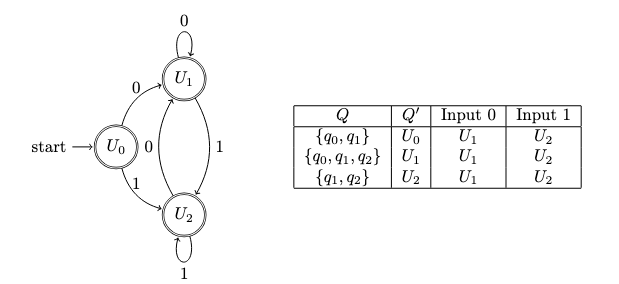TOC-As-2
Question 1
Convert the following NFA into an equivalent DFA. (20 pt)

First iteration
Second iteration
Third iteration

Question 2
Let
2.a.
2.b.
Question 3
Determine whether the following languages over
3.a.
Assume
By the pumping lemma,
If
only consists 's - Suppose
consists of . - Then
or , which is not in .
- Then
- Suppose
If
only consists 's - Suppose
consists of . - Then
, which is not in .
- Then
- Suppose
If
consists both 's and 's - Then
and in are intersecting with each other, which is not in the form of Thus, .
- Then
3.b.
Assume
By the pumping lemma,
If
only consists of 's - Suppose
consists of . - Then
, , which is not in .
- Or
, which is not in .
- Then
- Suppose
If
only consists of 's - Suppose
consists of . - then
, which is not in .
- Suppose
If
consists of both 's and 's - Then
and in are intersecting with each other, which is not in the form of Thus, .
- Then
3.c.
Assume
By the pumping lemma,
If
only consists of 's - Suppose
consists of . - Then
, , which is not in .
- Or
, which is not in .
- Then
- Suppose
If
only consists of 's - Suppose
consists of . - Then
, which is not in .
- Then
- Suppose
If
consists of both 's and 's - Then
and in are intersecting with each other, which is not in the form of Thus, .
- Then
3.d.
Since
Therefore, I can construct a NFA that accepts this language.

Question 4
Are the following languages regular? Prove your answer. (10 pt for each)
4.a.
By the pumping lemma,
If
only consists of 's - Suppose
consists of . - Then
, which is not in .
- Then
- Suppose
If
only consists of 's - Suppose
consists of . - Then
, which is not in .
- Then
- Suppose
If
consists of both 's and 's - Then
and in are intersecting with each other, which is not in the form of Thus, .
- Then
Although
we can not construct a NFA for
4.b.
By the pumping lemma,
If
only consists of 's - Suppose
consists of . - Then
, which is not in .
- Then
- Suppose
If
only consists of 's - Suppose
consists of . - Then
, which is not in .
- Then
- Suppose
If
consists of both 's and 's - Then
and in are intersecting with each other, which is not in the form of Thus, .
- Then

